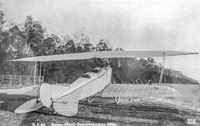
Описание
Страна: Германия
Год: 1913
J.Herris DFW Aircraft of WWI (A Centennial Perspective on Great War Airplanes 29)
DFW Pfeil Doppeldecker
The DFW Pfeil Doppeldecker (Arrow Biplane) followed the earlier DFW Mars biplanes with banana-shaped wing planform. The aircraft was smaller, lighter, and more streamlined than the Mars biplane for improved performance and agility.
Its compact design included a single bay of struts, greatly reducing drag compared to the three-and-a-half-bay Mars biplane. The engine was a 100 hp Daimler. The distinctive wing planform was not continued in future designs.
Описание:
- J.Herris DFW Aircraft of WWI (A Centennial Perspective on Great War Airplanes 29)
- P.Grosz, G.Haddow, P.Shiemer Austro-Hungarian Army Aircraft of World War One (Flying Machines)
Фотографии
-
J.Herris - DFW Aircraft of WWI /Centennial Perspective/ (29)
A DFW Arrow biplane provides a backdrop for this early photograph.
Herr Max Schuler (centre), who established a world's distance record with two passengers (seen in the photograph) by flying from Leipzig to Breslau - a distance of 205 miles - where he competed in the East German Race on his 150 h.p. D.F.W. scouting biplane. It was on the same machine, it will be remembered, that Herr Schuler won the German "Triangular" Race a short time ago. -
J.Herris - DFW Aircraft of WWI /Centennial Perspective/ (29)
A DFW Renn Pfeil Doppeldecker (arrow biplane) seen from the rear. (Peter M. Grosz Collection/SDTB)
-
J.Herris - DFW Aircraft of WWI /Centennial Perspective/ (29)
A DFW Pfeil Doppeldecker (arrow biplane) at a pre-war flight competition; the competition number is "24". (Peter M. Grosz Collection/SDTB)
-
J.Herris - DFW Aircraft of WWI /Centennial Perspective/ (29)
A DFW Pfeil Doppeldecker with early national insignia on a white background under the wing. This is indicative of the photo being taken during the war. (Peter M. Grosz Collection/SDTB)
-
J.Herris - DFW Aircraft of WWI /Centennial Perspective/ (29)
A DFW Pfeil Doppeldecker (arrow biplane) with pre-war registration under the lower wing.
-
J.Herris - DFW Aircraft of WWI /Centennial Perspective/ (29)
A DFW Pfeil Doppeldecker (arrow biplane) ready for flight. (Peter M. Grosz Collection/SDTB)
By 1914 the DFW company was producing elegant biplanes like this small two-seater. A production licence was agreed with Beardmore in the UK, but the war brought the scheme to an end. -
J.Herris - DFW Aircraft of WWI /Centennial Perspective/ (29)
This DFW biplane appears to be the same type as that shown in the beginning of the section on page 9. The wings have a straight leading edge in contrast to the swept-back wings of the DFW Pfeil Doppeldecker although they retain the single-bay bracing. The engine appears to be a 100 hp Daimler.
A "D.F.W." scouting biplane, which is credited with a maximum speed of 106 to 110 miles per hour, and a minimum speed of 51 miles per hour. She will climb to an altitude of 3,500 ft. in about 6 mins. -
J.Herris - DFW Aircraft of WWI /Centennial Perspective/ (29)
Early DFW biplane at right with a Taube at left ready for another sortie early in the fighting. (Peter M. Grosz Collection/SDTB)
Другие самолёты на фотографии: DFW Taube - Германия - 1913
-
J.Herris - DFW Aircraft of WWI /Centennial Perspective/ (29)
A DFW Pfeil Doppeldecker with crew aboard. (Peter M. Grosz Collection/SDTB)
-
J.Herris - DFW Aircraft of WWI /Centennial Perspective/ (29)
The DFW speed scout of 1914 was a single-seat, single-bay biplane with streamlined interplane and undercarriage struts designed for racing. The wings were shorter span than other DFWs and the tail resembled the DFW B.I. The engine was a 150 hp Benz Bz.III. This aircraft won the "Berliner Dreiecksflug 1914" competition. (Peter M. Bowers Collection/Museum of Flight)
-
J.Herris - DFW Aircraft of WWI /Centennial Perspective/ (29)
This DFW biplane appears to be a two-bay derivative of the biplane. The caption written on the photo indicates it was designed for the military and has a 150 hp engine. (Peter M. Grosz Collection/SDTB)
-
Журнал - Flight за 1914 г.
Two views of the 150 h.p. D.F.W. fast reconnaissance type biplane. Inset, the same machine in flight.
-
J.Herris - DFW Aircraft of WWI /Centennial Perspective/ (29)
A DFW Arrow biplane with low-drag radiator under the wing. It is not known how many of these aircraft were built before the war.
-
P.Grosz, G.Haddow, P.Shiemer - Austro-Hungarian Army Aircraft of World War One /Flying Machines/
The DFW “racing military biplane" shown here at the DFW factory is possibly the aircraft that participated in the Third International Flugmeeting as the Lloyd LS 1. For the competition a 145 hp Hiero engine and spinner were installed, possibly at Aszod by DFW workmen.
Другие самолёты на фотографии: Lloyd C.I - Австро-Венгрия - 1914














